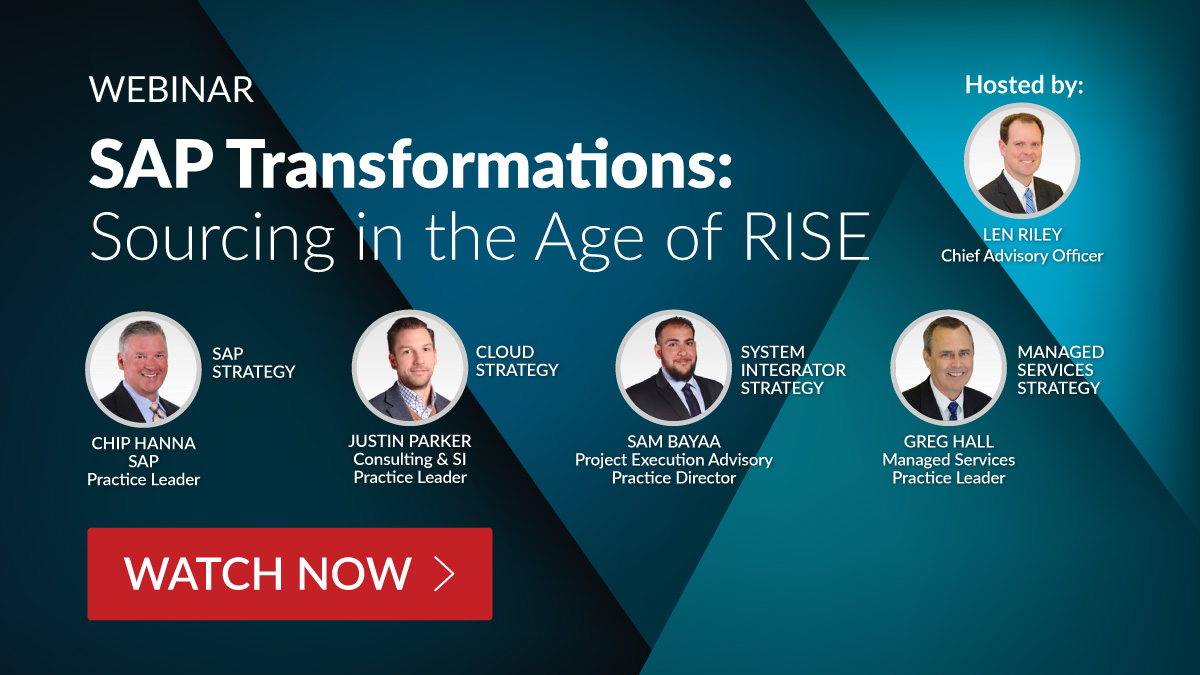- Len Riley
- Reading Time: 6 minutes

From upcoming support expirations to the hard-sell of RISE, SAP customers — and midmarket targets — can expect a cloudy future that will require complex evaluations and reimagined managed services relationships. The following are some SAP predictions for 2023.
With the threat of a recession looming, cost pressures increasing, and the deadline to move off SAP ECC swiftly approaching, SAP customers have a lot to consider as they plan for the year ahead.
Here are some of the trends we expect to play out as the year goes on, specifically for SAP customers.
1. SAP Will Hold Firm on Expiration of ECC Support
Though customers may be looking for an extension, we expect SAP will not extend the expiration of mainstream maintenance for SAP Business Suite 7 core applications beyond 2027. SAP has already extended the deadline once — in 2020, it extended support from 2025 to the end of 2027. We also expect SAP to position alternative support options, via its extended maintenance option, for an additional 2% on your maintenance base or customer-specific maintenance through 2030.
Customers will likely continue to believe that SAP has not presented a strong enough business case to upgrade to S/4HANA. However, it will be difficult to argue that SAP hasn’t provided ample opportunity to plan and execute an upgrade or understand the financial implications for delaying the move to S/4HANA. Any extension on SAP’s part would fly in the face of its strategic objectives. Customers need to consider this deadline as final and start preparing now if they haven’t already.
2. SAP Will Aggressively Position RISE
SAP’s agenda goes beyond migrating SAP ECC clients to S/4HANA. Migrating customers to RISE, its cloud offering on a subscription-based model, is of utmost importance. SAP RISE is the cornerstone of SAP’s long-term financial plan to secure increased renewal revenue.
SAP’s motivations and commitment to this offering were made clear back when its predictable revenue, a major factor in overall company valuation, was in the low 70s while other pure-play SaaS providers were in the low to high 90s. In its 2022 year-end earnings call, SAP boasted predictable revenue of 79% with aspirations to reach 85% by 2025. The stakes for SAP are high and customers should anticipate that SAP’s sales and negotiation tactics will reflect that and will include:
- A highly coordinated approach/advocacy for RISE adoption throughout the partner network, including systems integrators (SI) and hyperscaler partners
- Positioning the long-term vision, product development, and innovation to be focused on RISE vs. S/4HANA On-Premise
- Leveraging executive-level client relationships to influence and offset potential deficiencies in RISE identified by client evaluation teams
- Offering highly unfavorable pricing and commercial terms related to S/4HANA On-Premise license arrangements vs. historical SAP practices
Customers should anticipate the pressure SAP will apply for RISE adoption and prepare their organization to proactively manage SAP executive-level relationships. It’s also advisable for customers to conduct a thorough review of their SAP agreements and commercial protections before assuming a false sense of security with respect to their purchase or negotiation position for additional on-premises licenses.
3. Customer’s Will Struggle with RISE Evaluations
Many clients have yet to come to the realization that the evaluation of RISE is more akin to evaluating a managed services offering than a pure-play SaaS solution. Companies also are at risk of underestimating the complexities and implications related to their existing operations and adjacent partner relationships. For example:
- It’s in SAP’s nature to sell software, not a managed service offering. At worst, they will avoid the conversation completely, and at best, they will try to stay at a high-level on critical topics like environment sizing, roles and responsibilities, and modifications to service-level commitments.
- Most SAP ECC and S/4HANA customers have third-party support relationships, either in the form of traditional on-premises infrastructure support, cloud managed services, and/or application maintenance and support. An assessment of the current and future state of these relationships should be conducted in parallel with the RISE evaluation.
- Although SAP provides the flexibility to allow a customer to select its hyperscaler of choice through the RISE model, many customers already have or are contemplating sizable commitments to AWS, GCP, and Microsoft Azure. These companies have enjoyed sizable investments from hyperscalers in exchange for workloads. The question customers must answer is whether it’s in their interest to sever their hyperscaler relationship through an SAP RISE offering.
Customers who anticipate the complexity of their RISE evaluation and proactively develop an integrated sourcing and evaluation strategy will be positioned to make more informed and effective decisions.
4. SAP Will Target Midmarket Companies
We expect SAP to put significant energy into capturing more of the midmarket as these companies are more likely to adopt a single, vertically integrated solution like RISE. Unlike most enterprise-level companies, midmarket companies are nimbler and faster in their decision-making process and more likely to seek a single partner versus a multi-partner strategy. These companies are also more likely to implement SAP RISE faster than an SAP enterprise customer. All these factors present a meaningful opportunity to SAP. Because of this, these midmarket companies should be asking:
- Is SAP presenting a commercial model that allows our organization to scale in a financially responsible manner?
- Is SAP presenting prospective implementation partners capable of successfully delivering the project?
- Is SAP and its implementation partners presenting a realistic view of the program scope, approach, and requirements for success?
5. Consulting Firms Will Invest in ‘Phase 0’ Initiatives
Although it’s too early to give up on growth in 2023, we anticipate that the consulting and system implementation community will emphasize growth for 2024 and beyond via continued positioning of Phase 0 initiatives. We view this as an opportunity for companies that are not currently undertaking an SAP ECC to S/4HANA migration and do not expect the funding to commence their journey to S/4HANA until late 2023 or early 2024.
That said, every opportunity comes with a price and potential downstream risks that companies would be advised to consider as they undertake Phase 0 initiatives. We recommend keeping the following questions in mind:
- Is the Phase 0 consulting firm a likely candidate for the implementation phase? If so, is your strategy to sole source? Does your timeline allow for an SI RFP process? Is there a potential for your organization to lose negotiation leverage by walking into an unplanned sole-source situation?
- What is the scope of the Phase 0? Is the scope aligned solely to the consulting partners methodology, or does it consider the requirements your company has to actually approve to proceed to the next phase of the project?
- Does your plan, board of directors, or regulatory commission call for an independent review and validation of the business case and strategy? If so, what is your plan to obtain such an independent perspective?
- Does the scope of your Phase 0 include the development of an integrated sourcing strategy designed to enable the evaluation, selection, and negotiation of multiple workstreams (including SAP software, implementation services, hyperscaler services, cloud managed services, and application maintenance and support)?
Before customers take advantage of the “time” to plan in 2023 and the investments that both SAP and consulting firms are willing to make in Phase 0 initiatives, they should think through the end-to-end decision process and their requirements rather than default to the approach and strategies proposed by any partner.
6. SAP Customers Will Continue to Migrate to the Cloud
We anticipate that customers committed to staying on SAP ECC or planning to migrate to SAP S/4HANA while maintaining their perpetual licenses will continue to aggressively move to the cloud. Some companies will do so proactively, while others may be compelled to do so as a result of changes in the strategy of their existing managed services providers (e.g., Kyndryl and Dell Virtustream).
In addition, many companies will be making this migration in a context that goes beyond their SAP environment, including other application workloads and non-SAP transformational initiatives with AWS, Google, and Microsoft. As companies consider their overall cloud strategy, they should consider the following:
- Evaluate SAP RISE in conjunction with their hyperscaler relationship and cloud managed services relationships to allow for effective decision-making and manufacturing of leverage.
- Take inventory of existing application and cloud migration roadmaps and future growth projections, as our experience shows that many organizations are blowing through their spend commitments very early in their agreement term.
- Assess their existing hyperscaler agreements, including spend commitments and incentives to determine whether they are market competitive and will scale commercially to account for future growth.
7. Customers will Reimagine Managed Services Relationships
In conjunction with the cloud migration, we believe companies will continue to reimagine their operating models and existing managed services relationships. The introduction of SAP RISE, the market disruption caused by the hyperscalers, and the continued pressure to reduce operating cost and improve operating scale will serve as the primary drivers in this area. As organizations reimagine their future state, they will be compelled to ask and answer the following:
- Would it be more efficient to build a cloud center of excellence (COE) internally or proceed with a managed services model?
- Should I proceed with my incumbent on-premises managed service provider or select a new cloud managed service provider?
- Can I leverage my system integrator and SAP to provide a comprehensive managed services solution, such as Accenture’s SOAR offering, or proceed with a multi-vendor approach?
- Can I leverage the selected S/4HANA systems integrator or my existing SAP ECC application management services (AMS) provider to provide application maintenance and support?
Although SAP may serve as a major consideration with respect to the overall strategy, many organizations have managed services relationships that expand well beyond the boundaries of SAP, including security services, non-SAP AMS, help desk services, field services, etc. Renegotiating these relationships and assuming a partial termination of existing services will also need to be considered as part of an overall strategic sourcing plan.
Many companies are well on their way to tackling these decisions. But the vast majority of SAP’s install base is just starting this journey and are likely to be leveraging the majority of 2023 to develop and execute a strategy to answer these questions.
Reprinted with permission. © IDG Communications, Inc., 2023. All rights reserved.

